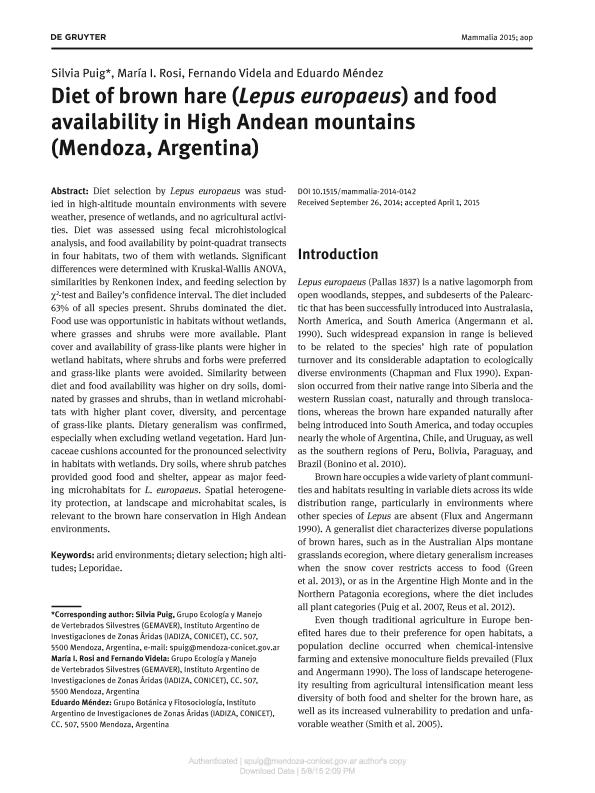Artículo
Diet of brown hare (Lepus europaeus) and food availability in High Andean mountains (Mendoza, Argentina)
Fecha de publicación:
05/2016
Editorial:
De Gruyter
Revista:
Mammalia
ISSN:
0025-1461
Idioma:
Inglés
Tipo de recurso:
Artículo publicado
Clasificación temática:
Resumen
Diet selection by Lepus europaeus was studied in high-altitude mountain environments with severe weather, presence of wetlands, and no agricultural activities. Diet was assessed using fecal microhistologicalanalysis, and food availability by point-quadrat transects in four habitats, two of them with wetlands. Significant differences were determined with Kruskal-Wallis ANOVA, similarities by Renkonen index, and feeding selection by χ 2 -test and Bailey ? s confidence interval. The diet included 63% of all species present. Shrubs dominated the diet.Food use was opportunistic in habitats without wetlands, where grasses and shrubs were more available. Plant cover and availability of grass-like plants were higher in wetland habitats, where shrubs and forbs were preferred and grass-like plants were avoided. Similarity between diet and food availability was higher on dry soils, dominated by grasses and shrubs, than in wetland microhabitats with higher plant cover, diversity, and percentage of grass-like plants. Dietary generalism was confirmed,especially when excluding wetland vegetation. Hard Juncaceae cushions accounted for the pronounced selectivity in habitats with wetlands. Dry soils, where shrub patches provided good food and shelter, appear as major feeding microhabitats for L. europaeus. Spatial heterogeneityprotection, at landscape and microhabitat scales, is relevant to the brown hare conservation in High Andean environments.
Palabras clave:
Arid Environments
,
Dietary Selection
,
High Altitudes
,
Leporidae
Archivos asociados
Licencia
Identificadores
Colecciones
Articulos(IADIZA)
Articulos de INST. ARG DE INVEST. DE LAS ZONAS ARIDAS
Articulos de INST. ARG DE INVEST. DE LAS ZONAS ARIDAS
Citación
Puig, Silvia; Rosi, Maria Irene; Videla, Fernando; Mendez, Eduardo; Diet of brown hare (Lepus europaeus) and food availability in High Andean mountains (Mendoza, Argentina); De Gruyter; Mammalia; 80; 3; 5-2016; 293-304
Compartir
Altmétricas




